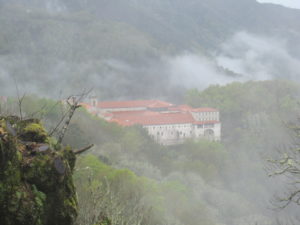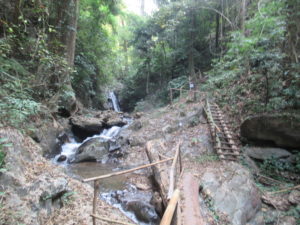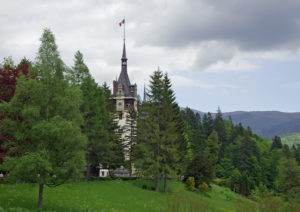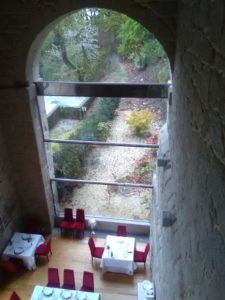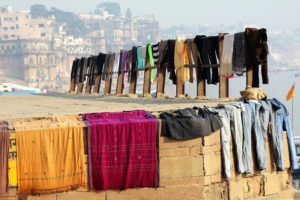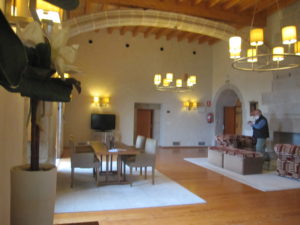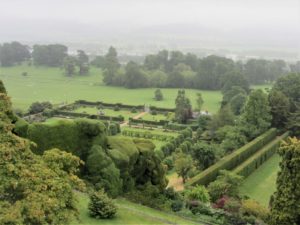Over the years we have visited several Paradors while visiting areas of Spain, both North and South. This year, we were visiting Northern Spain and wanted to try a relatively new one, located in Galicia.
Starting out from Santander with a hired car, our aim was to travel west to Galicia, then return, visiting other locations en route. From Santander, this is about 540 km – a long journey to do in one day as it is fairly close to Ourense and Santiago de Compostelo which sits far west.
With two of us driving in turn and using the main roads this was achieved – leaving at 10 am and arriving at Parador de Santo Estevo at 5.30 with a stop for lunch.
This Parador, with its 77 rooms in 3 cloisters of different styles and periods first opened its doors on July 28th 2004. It was converted from a Benedictine monastery dating back to the 6th century, to a Parador hotel, located in a beautiful, high natural area deep in deciduous forests of oak, chestnut, birch and laurel. Built in Galician Romanesque style, it was designed on the basilica plan and divided into 3 naves, each of 4 sections closed by 3 apses. The roof was originally wood, but was replaced in the 16th century by its present, ribbed vaults.
There appears to be more than one access road, and I think we took the highest, winding route! You need to take the local Luintra road and follow the signs, which I think there should be more of on this mountain road.
Having left Santander with fairly good weather, it sadly changed as we travelled further west. Approaching, I guess you would describe the parador as being hidden within a great cloak of green woods, but what a sight to behold as the road takes you slightly above it, before descending to the place itself.
We parked outside the main entrance to unload for our 2 day stay before moving the car to an underground parking area with the entrance, only a few yards away. Your vehicles are kept dry and I guess, it makes the place look much tidier!
We were welcomed at reception, given some literature and shown to our room – 206, on the second floor.
Our room was quite spacious, clean, tastefully decorated and had a television and air conditioning. Wi fi was available but you had to move around to communal areas to be able to pick it up! The rooms are quite interesting because they are all different, some with impressive landscape views and others looking over the valleys of the river Sil. The room was lovely and warm as we entered, which was most welcome on a late April day. The whole place must cost a great deal to heat because there are areas which are open (courtyards) then you step through glass doors and corridors with large glass windows where the heat is retained.
There is a restaurant with a patio and a bar in the Porteria cloister. This was the old stables and the space forms a 14 metre high vaulted ceiling and is 50 metres long.
We ate in the the rather unique dining room at 8.30. As we were early, we were given a table which looked out across the valley which amazingly had a beautiful sunset (before the rain arrived the next day)!
I had an Octopus and potato starter followed by salmon, which was delicious. You can have both international and local dishes. There is also a gluten free menu. The chef is proud of the wide selection of fish recipes from the River Sil as well traditional dishes of the region.
Service staff were friendly, professional and very attentive.
The place has a banquet room as well as a meeting room. Gardens have a variety of local plants. It is such a large place that you could easily miss a lot, but I will remedy that further on.
We woke up to mist and rain the following morning, but after a light breakfast left around 11 am to have a look around in the car. There were plenty of ‘mirador’ spots, but it was so misty and wet you couldn’t see much! We stopped at the nearby, small town of Luintra and had some real, local soup in the Cafe Os Corzos, a busy place, frequented by locals.
Just outside Luintra we came upon Mamoas de as Cabanas – a burial place which had tombs scattered over a field.
Over 3,000 years ago, the ancient inhabitants of Galicia, used to bury their dead and their leaders in tombs built with large, granite slabs. The tombs were later covered with earth in the shape of a breast. In Galicia they are called domens. Numerous legends inhabit these places. A widespread period of looting took place in the 17th century, in search of bullion, allegedly hidden in the megalithic mounds.
Outside the Parador there are various things you can do, which sound great when the weather is good! You can go on a Canyon Boat Trip which is located 15 minutes from the Parador. The duration of the trip is 90 minutes. If you choose to do the trip by car you can take what is called a ‘Sightseeing Balconies Tour’ where you can see the canyons from the top of the mountain.
Winery visits can be made where you can discover the wine characteristics and the peculiar way of harvesting.
Two wine estates in the Riberia Sacra (holy river bank) are carved into the steep hills. After Roman times, monks took over and carved terraces of vines into the slopes of the rivers, where today, thousands of tonnes of grapes are harvested from the slopes. The slopes are so steep they have to be accessed on foot by grape pickers who do the back breaking work. There is limited vehicle access to the slopes, so wine makers have to improvise by using make-shift pulley systems and boats to move the produce.
A few minutes from the Parador is a couple of monasteries you can visit, San Pedro de Rocas and Santa Christina.
As well as hiking trails there is a Montealegre Golf Camp, 20 minutes from the Parador.
In the Parador itself, you can pamper yourself with Spa and Treatments.
A guide, dressed as a monk conducts a one hour tour where you can learn about the history of the Monastery. It wasn’t available while we were there.
From the Cafeteria, you can access the monastery’s wood which has 2 hectares of open space.
I said earlier about how big the Parador was. To ensure you don’t miss anything, you can visit the Monastery cloisters which have informative panels placed in different locations where you can gain a first-hand knowledge of the history of the Monastery and the use of the areas in the past. You follow the numbers beginning in the main entrance from the square. There are 33 of them. My advice is to locate and read the 33 wall plaques placed throughout, including the attached church, not only to learn the history of each location, but to see the variances in design and décor of each area.
(We did this and by doing so, visited a floor which had a great exhibition on show by Florencio de Arboiro. Over 30 years ago, this sculptor, taught by his grandfather, began collecting and restoring different grinding wheels and other pieces of folk art. He intended to recover the ‘travelling industry’ (footloose tradesmen) who lived in the many Ourense counties. He went around villages collecting and now has the largest collection in the world of grinding wheels, bicycles and motor bikes – appliances for sharpening knives.
We spent ages looking at the many small bronze sculptures on display, which were fascinating.
Plaque 1 tells how the Monastery was one of the most important in the province, built in a region of hermitages. In 921 king Odono granted it to the Abbot Franquita, who restored the buildings and inaugurated a period of splendour within their walls. Santo de Estevez had a reputation for religious observance which spread far and wide, and nine sainted bishops who were forced to leave their posts due to the Saracen invasion, chose it for their retirement. This turned the Monastery into a place for pilgrimage. The faithful gathered, searching for miracles, beseeching the bishops before the silver coffer containing 9 rings.
Without going into individual details, the other plaques include the Almsgiving Door, Monastery ground floor plan, Claustre Dos Bishops, Miracle of Dona Goto, Abbey Infirmary, landscapes monastery delicacies, architectural styles etc., etc.
What a start to our 10 day trip. Visitors have an excellent opportunity to enjoy this privileged place on to a beautiful and spectacular part of the Iberian Peninsula. Travellers can enjoy unique crafts, shared cuisines, customs and culture, festivals and much more in a pleasant climate. It is just a shame we had the rain and missed out on some of the fantastic scenery!
